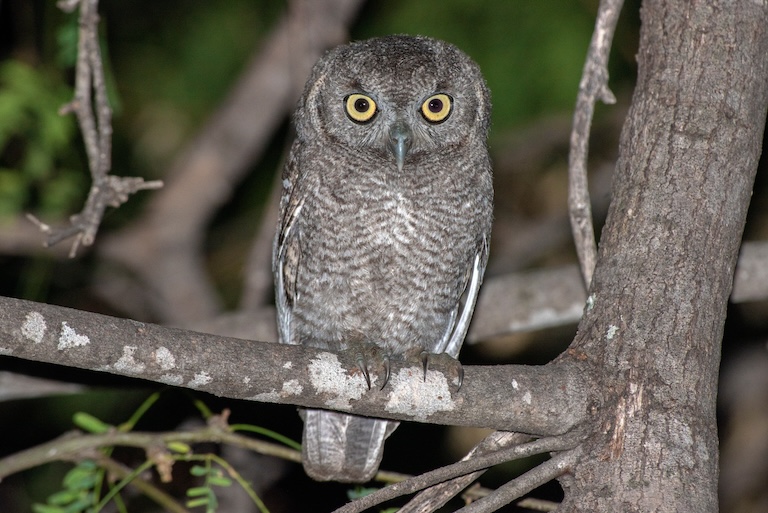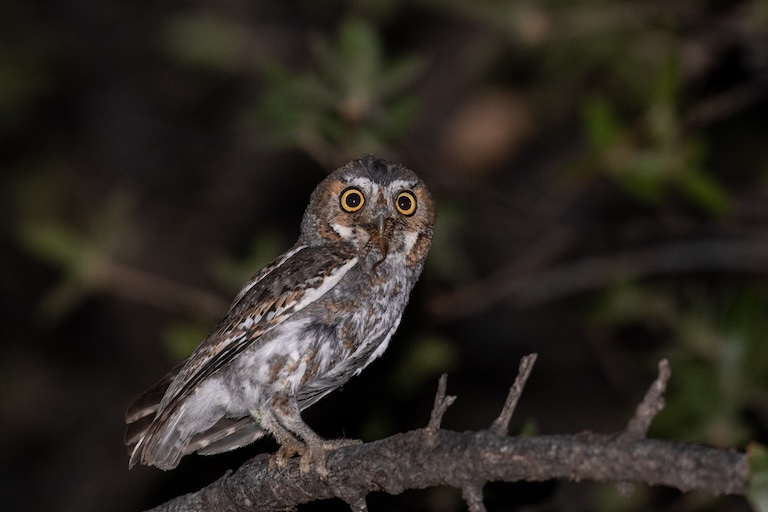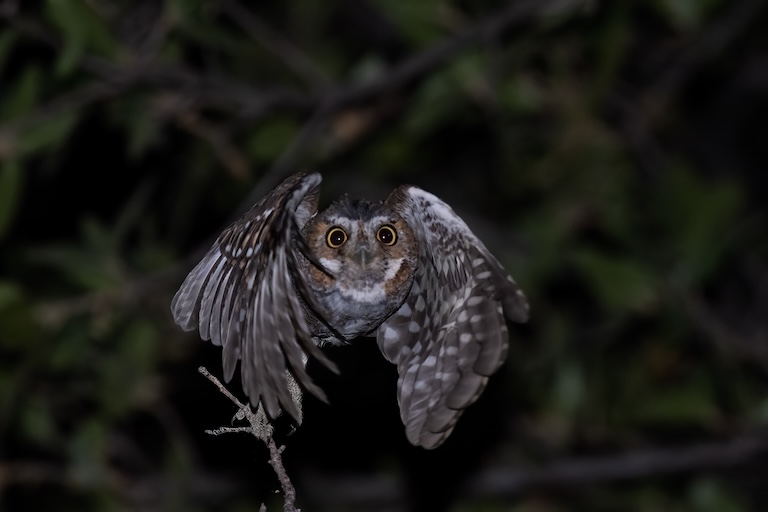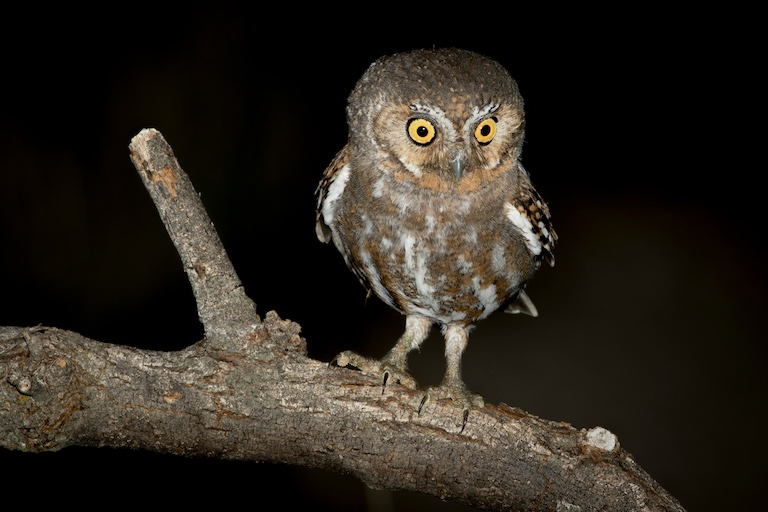Elf Owl Profile
Not since Dio has the name Elf been associated with a more powerful little dude. Elf owls are some of the smallest raptors alive, and while this leads them to situations of bullying by the larger birds, they are still raptors, and to their prey, they’re elite hunting machines. Adorable, elite hunting machines.

Elf Owl Facts Overview
| Habitat: | Mostly shrubland, grassland, but also deserts, thorn woodlands, evergreen woodlands and riparian forests |
| Location: | Southern US and Mexico |
| Lifespan: | 6 years in the wild, 14 in captivity |
| Size: | 15 cm (6 in) long |
| Weight: | Rarely more than 40 g (1.4 oz) |
| Colour: | Greyish-brown with buff mottling, yellow eyes and white or brown cheeks |
| Diet: | Arthropods such as moths, crickets, scorpions, centipedes, and beetles; some small mammals, spiny lizards |
| Predators: | Jays, hawks, other owls, snakes |
| Top Speed: | Unknown |
| No. of Species: | 1 |
| Conservation Status: | Least Concern (IUCN) Endangered in California |
Elf owls are tied for the record of smallest owl, though they likely just nudge out the competition. These are very little birds, and they may even be a solid contender for the smallest raptor.
Their littleness is cute, but it does cause them trouble: they’re commonly mobbed by bigger birds, some of which will even eat them if given the chance. So, they play dead. Few non-vulture raptors want to eat a dead owl, and so they often get away with it.
Once their bullies have left, these owls dominate the arthropod world, ripping the stings off scorpions and laying into anything that scurries, including some small mammal species.
Interesting Elf Owl Facts
1. They’re tiny
People often forget about owls when talking about raptors, and this might explain why the falconets are so frequently listed as the world’s smallest raptors.
But by all accounts, the elf owl should share that accolade, being pretty much the same size.
Elf owls can be as little as 12 cm long when fully grown and rarely pass 15 cm.
This is about the size of a sparrow, but unlike the sparrows, they generally don’t move with an entourage, which makes them a great target for bird bullying. 1

2. They mob and get mobbed
Being bite-sized, they are sometimes bitten. Great horned owls are one of the top predators of elf owls, both as juveniles and as adults.
Mexican jays will also have a go, though being nocturnal does help the owl somewhat in avoiding predation by diurnal raptors.
Arboreal snakes can sneak up on owls, but more often these little raptors are mobbed by larger birds just because they can.
Still, while generally solitary animals, elf owls make good neighbours, and will mob in turn any predator they see sneaking up on their kin.
If a predator is spotted, a small group of up to 4 neighbouring owls will make it very clear the enemy has been spotted, cooperatively attacking the head of the intruder and ruining its stealth attack.
3. They play dead
Sometimes this isn’t enough, and the elf owl needs to bring out the big guns. Being petite, this involves desperately pretending to be dead as a way of making their meat less appetizing.
Predators instinctively respond to a struggle, and conversely will often release their grip in its absence, so behaving like a rotting corpse can save an owl who was unlucky enough to get nabbed in the first place.
But while they are forced by their diminutive size to resort to sneaky tactics to survive, to those animals smaller than the elf owl, they’re formidable! 2
4. They’re scorpion hunters
As true raptors, these little birds can take small vertebrates as food. These will usually come in the shape of lizards, birds and kangaroo rats, but the majority of their diet comes from invertebrates, such as insects and arachnids.
Scorpions are a valiant foe for such a small bird, but the elf owl is adept at dispatching them.
While the bird has an apparent resistance to the stings, they will also take the time to remove the bulb from the tail of a scorpion before feeding on it. 3

5. They nest in cactuses
Being tiny has some advantages when looking for a nest. Many crevices too small for larger and more dangerous animals are a perfect hiding place for a little owl, and elf owls aren’t too fussy about the location.
They’ll nest in deserts, woodlands, montane forests and even urbanised areas, and they prefer to make use of abandoned woodpecker holes, which can be found in many structures but are certainly the easiest way to set up shop inside a cactus.
Looking at the enormous saguaro cactus in Arizona, you might suddenly spot a pair of yellow eyes looking back at you: an elf owl staring you down from its tiny hole in the side of the plant. 4
6. They’re unwitting snake farmers
Among their eclectic food preferences are snakes, and particularly blind snakes, which are small and harmless enough to feed to children.
But it’s been documented that the children, being malcoordinated in the way children always are, sometimes let one slip, and the escapee, instead of fleeing finds the nest to be quite a useful place to live.
The snake gets to feed on all the ants, maggots, and other critters within the nesting material, and this in turn protects the food caches dedicated to the juvenile owls from those pests.
In other species, tree ants live within the nest and will attack intruders but comfortably live alongside the owls, so it’s also possible this is the case with Elf owl nests, but this hasn’t been confirmed yet.
7. They’ve got no chill
Tiny animals have a hard time with temperature. When an elf owl gets too hot, it flattens its deathers and becomes scrawny-looking. It then holds its little wings out away from its body and starts panting.
They struggle so much at keeping cool that it’s assumed they weren’t really built for desert life and were instead just living there because the niche was open.
Because to Sonoran desert is only 8,000 years old, these owls likely evolved to live in the evergreen woodlands that it once was and haven’t fully adjusted to the new normal yet.

Elf Owl Fact-File Summary
Scientific Classification
| Kingdom: | Animalia |
| Phylum: | Chordata |
| Class: | Aves |
| Order: | Strigiformes |
| Family: | Strigidae |
| Genus: | Micrathene |
| Species: | whitneyi |
Fact Sources & References
- “Elf Owl”, Owling.
- “Micrathene whitneyi elf owl”, Animal Diversity Web.
- “Elf Owl Pictures, great pictures of elf owls in the outdoors”, Owl Pictures.
- John Uscian (2017), “Elf Owl Quest”, YouTube.
